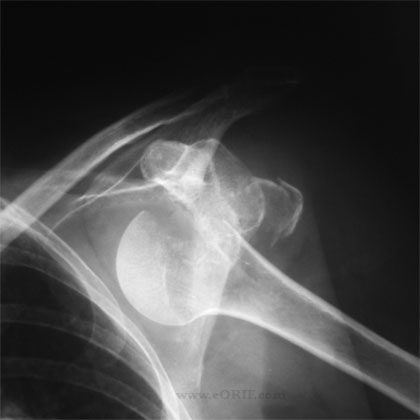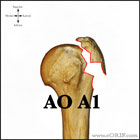|


|
synonyms: proximal humerus greater tuberosity fracture, greater tuberosity fx
Greater Tuberosity Fracture CPT
Greater Tuberosity Fracture ORIF Anatomy
- Greater tuberosity = insertion of supraspinatus, infraspinatus, and teres minor tendons
- Lesser tuberosity = insertion of subscapularis tendon.
- Displaced greater tuberosity fx is pathognomonic of a longitudinal tear in the rotator cuff at the rotator interval between the supraspinatus and subscapularis tendons.
- Primary blood supply to humeral head is the ascending (arcuate) branch of anterior humeral circumflex artery which runs in the bicipital groove.(Jaberg, JBJS 74A:508;1992) Less significant supplies include the posterior humeral circumflex artery and small vessels enteriing through the rotator cuff insertions.
- Humeral head vascularity after fracture can be estimated by the amount of metaphyseal head extension, <8mm is associated with ischemia; Medial hinge disruption >2mm is associated with ischemia. If both indicate ischmia the positive predictive value of ischemia for an anatomic neck fx is 97%. (Hertel R, JSES 2004;13:427).
- Anatomic Landmarks
-Mean distance between the pectoralis major tendon and the top of the humeral articular surface is 5.6cm (Murachaovsky J, JSES 2006;15:675).
-Normal distance from the greater tuberosity to the superior protion of the articular surface of the humeral head = 7-8mm (Iannotti JP, JBJS 1992;74A:491), (Takase K, JSES 2002;11:557).
-The neck-shaft inclination angle averages 145 degrees. The humeral head is retroveted an average of 30 degrees.
- Deforming forces: Pectoralis major pulls the shaft medially, anteriorly and internally rotates. Supraspinatus abducts the head fragment in two part fractures. If greater tuberosity is fractured it is pulled superiorly and posteriorly by the suprspinatus and infraspinatus. Lesser tuberosity fractures are pulled medially.
Greater Tuberosity Fracture ORIF Indications
- Greater tuberosity fractures which are displaced >5-10mm either superiorly or posteriorly can lead to painfull malunions with loss of function.
Greater Tuberosity Fracture ORIF Contraindications
- Poor bone quality
- Medically unstable patient
- Active infection
Greater Tuberosity Fracture ORIF Alternatives
- CRPP
- Non-operative management
Greater Tuberosity Fracture ORIF Pre-op Planning / Case Card
- Develop preoperative plan based on pre-operative radiographs using AO technique.
- Consider getting xrays of normal side to aid in pre-op planning.
- Consider CT scan.
- Anatomic Landmarks
-Mean distance between the pectoralis major tendon and the top of the humeral articular surface is 5.6cm (Murachaovsky J, JSES 2006;15:675).
-Normal distance from the greater tuberosity to the superior protion of the articular surface of the humeral head = 7-8mm (Iannotti JP, JBJS 1992;74A:491), (Takase K, JSES 2002;11:557).
-The neck-shaft inclination angle averages 145 degrees. The humeral head is retroveted an average of 30 degrees.
Greater Tuberosity Fracture ORIF Technique
- Pre-operative antibiotics, +/- interscalene block
- General endotracheal anesthesia
- Modified beach-chair position. All bony prominences well padded.
- Examination under anesthesia of affected shoulder.
- Prep and drape in standard sterile fashion. Have a well-padded height adjustable Mayo stand or shoulder positioner available to hold the arm during the case.
- Repair the rotator interval.
- Irrigate.
- Close in layers.
Greater Tuberosity Fracture ORIF Complications
- Primary / secondary screw perforation of the humeral head (SudKamp N, JBJS 2009;91A:1320).
- Subacromial impingement
- Nerve injury palsy: Axillary
- Infection
- Loss of reduction
- Need for further surgery
- Hardware failure
- Stiffness
- Pain
- Avascular necrosis of humeral head
- Nonunion
- DVT/PE
- Risks of Anesthesia including heart attack, stroke and death.
Greater Tuberosity Fracture ORIF Follow-up
- Patients are placed in a shoulder immobilzer with an abduction pillow (Ultrasling) post-operatively. Pendulum, elbow, wrist, hand ROM is started immediately.
- F/U at 7-10 days to remove sutures, check xrays and start passive ROM in physical therapy.
- Active ROM and strengthening are started after xray evidence of fracture healing.
- Return of ROM and strength can take 6months to 1 year.
- Proximal Humerus Fracture Rehab Protocol.
- Shoulder outcome measures.
Greater Tuberosity Fracture ORIF Outcomes
Greater Tuberosity Fracture ORIF References
|


